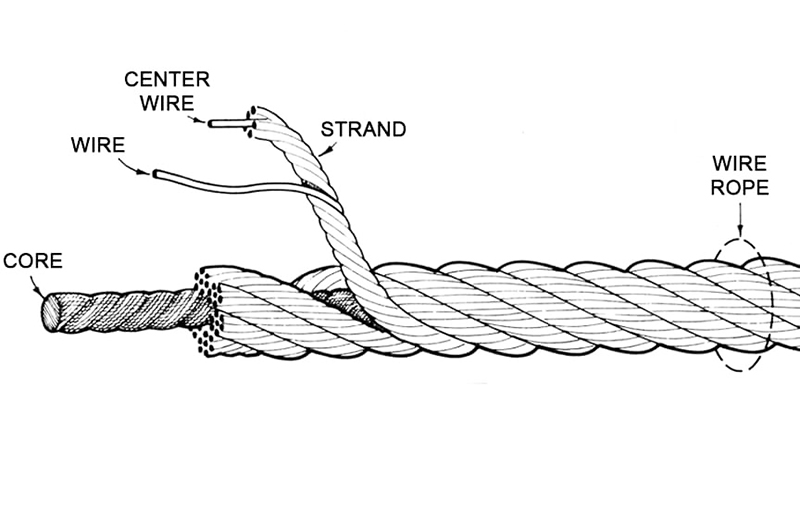Introducing our revolutionary High Strength Crane Wire Rope, designed to meet the toughest demands of heavy lifting operations. Crafted with precision and engineered to perfection, this premium wire rope offers unparalleled strength and durability. With a high tensile strength and exceptional resistance to wear and tear, it ensures safe and efficient lifting of heavy loads in various industries. The advanced construction of this wire rope guarantees minimal stretch, reducing the risk of accidents and enhancing stability during lifting operations. Trust our High Strength Crane Wire Rope to deliver exceptional performance, reliability, and peace of mind for all your lifting needs.
High Strength Crane Wire Rope
Wire Rope is a preferred Crane Parts for many reasons. Its unique design consists of multiple steel wires that form individual strands laid in a helical pattern around a core. This structure provides strength, flexibility, and the ability to handle bending stresses. Selecting the proper wire rope for your lifting application requires some careful thought.
Componebts of Wire Rope
There are four basic components that make up the design of a finished wire rope:
- Wires made from metal that form a singular strand
- Multi-wire strands laid around a core in a helical pattern
- A fiber or steel core
- Lubrication

Specifictions(for Verlinde Hoist)
| Hoist Type | Diameter | Structure | Strength Grade N/mm² | Surface Treatment | Weight Per Meter Kg/m |
| VT1(Single) | 6.2mm | 8*17 | 2160 | Galvanized steel | 0.17 |
| VT2(Single) | 8.0mm | 8*19 | 2160 | Galvanized steel | 0.33 |
| VT3(Single) | 11.0mm | 8*19 | 2160 | Galvanized steel | 0.62 |
| VT3(Double) | 8.0mm | 8*19 | 2160 | Galvanized steel | 0.33 |
| VT4(Single) | 15.0mm | 8*26 | 2160 | Galvanized steel | 1.14 |
| VT4(Double) | 11.0mm | 8*19 | 2160 | Galvanized steel | 0.62 |
| VT5(Double) | 15.0mm | 8*26 | 2160 | Galvanized steel | 1.14 |
The following terms help to define the construction and properties of wire rope:
- Length
- Size
- Preformed or Non-Preformed
- Direction and Type of Lay
- Finish of Wires
- Grade of Rope
- Type of Core
Product Features
Designed for higher breaking strength and better strength to weight ratio, our crane wire rope is made of high-toughness steel wires that have been stretched to their tolerance limit prior to being stranded together to form a rope with optimum spacing between each strand.
Even if wire strands are tightly twisted, there still be spaces in places where the strand touches with each other. To improve the fill factor of the wire rope, we have added irregularly-shaped wire strand to the rope and sent it through rotary swaging process. Steel wires that are laid in a parallel pattern increase the cross section of the rope.
Special-purpose steel rope is commonly seen in various engineering projects. Via precision design and rigorous test, the rope usually can meet very high safety standards. A large number of wires are arranged in a parallel pattern to form a strand. Various strands then are twisted to produce the steel rope. Such a rope-making method ensures an improved safety performance of the rope
Our rotation-resistant wire rope contains several strands laid helically around an independent rope core. The lay direction of outer strands is opposite to that of the independent core so that the overall rope can be non-rotating. This series of rope mainly functions as a lifting tool in the crane. It also can be used in a rope take-up system that requires many times of rope winding.
Increasing the number of strands within a rope and wires in a strand can lead to an extended contact between the rope and the sheave groove or grooved cable drum, thereby reducing the stress acted on average rope. Through adding irregularly-shaped strand to the wire as well as rotary
Swaging process, this contact area will increase to greater extent, as with the decrease of rope stress. Greater flexibility of our Steel Wire Rope means that it can be wound in smaller, tighter circular patterns. When installing the rope onto the drum assembly, its steel and plastic combination design will increase the stability of the whole structure, avoiding internal wire breaking which in turn extends its use life.
